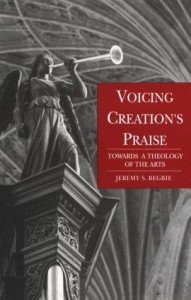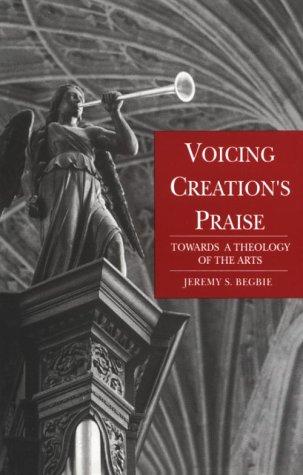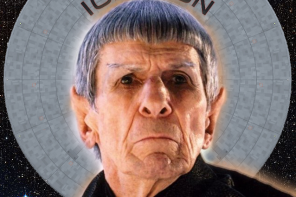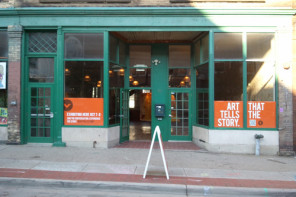 We have now arrived at the fourth installment of our series on comparing divine and artistic creativity. In previous posts, Part II and Part III, I considered two different theological approaches to human creativity. The first roots creativity in the structure of humanity, while the latter roots creativity in the function of humanity. The first is concerned with what humans are, and the second is concerned with what humans do. The third approach – the relational approach – significantly changes the terms of the game.
We have now arrived at the fourth installment of our series on comparing divine and artistic creativity. In previous posts, Part II and Part III, I considered two different theological approaches to human creativity. The first roots creativity in the structure of humanity, while the latter roots creativity in the function of humanity. The first is concerned with what humans are, and the second is concerned with what humans do. The third approach – the relational approach – significantly changes the terms of the game.
According to the relational approach, humanity images God when it is in right relation to God.[1] The relational approach encourages one to view the image of God in relation to the image of Christ (imago Christi) because it is in the person and work of Christ that humanity is shown to be in right relationship with God.
Because it situates the image of God in relation to Christ, the relational approach is significantly different from either the structural or functional approaches. The relational approach holds onto the important insight of the structural approach – creativity is an essential part of being human – but orients the nature of humanity in the person and work of Christ. The relational approach also agrees with the functional approach that creativity is part of the vocation of humanity, but it looks to Christ as the ultimate fulfilment of that vocation. By placing artistic creativity in relation to the redemptive work of Christ, the relational approach lends itself to a participatory relation between God and humanity. Just as Christian theologians have always affirmed the real and full humanity of Jesus, the doctrine of the incarnation suggests that God’s creativity does not negate human creativity but leaves something for human creativity to do.
Jeremy Begbie’s
Voicing Creation’s Praise is, perhaps, the most influential example of this approach.
[2] Begbie situates artistic creativity within a larger trinitarian context:
We can begin by recognising that in the humanity of Christ, our humanity has been incorporated into the divine life by the Son of God, set free by the Spirit from its debilitating self-obsession, from its self-will and its evasions of the truth, liberated to respond to the Father’s love and his will, and freed to respond appropriately to the created world. Therein lies the very foundation and source of authentic freedom and authentic creativity.[3]
He envisages the artist’s unique role as a “priest of creation”: “to articulate and extend that praise in ever fresh ways … In human kind, creation finds a voice.”[4] Begbie explores a comparison between divine and artistic creativity, but he does so obliquely by applying the same terms to both. Both divine and human creativity ‘respect’ and ‘redeem’ creation. For example, he says that in artistic creativity “there will be a redeeming of disorder, mirroring God’s redeeming work in Christ, a renewal of that which has been spoiled…”[5] Begbie clearly suggests a comparison between divine and artistic creativity in which the artist imitates the character of God’s creativity, but Begbie does not develop this comparison extensively.
By describing divine and artistic creativity as participatory, those who take the relational approach raise two further interesting theological questions. First, do artists add anything new to the cosmos? Recall that those who take the functional approach are wary of the concept of creativity for this reason, but a participatory relationship allows one to suggest that artistic creativity does bring an “added value” to the world without challenging the sovereignty of God. Second, what kind of cosmos can accommodate this vision of artistic creativity? These thinkers often challenge the notion of the ‘givenness’ of creation as something static in favour of a dynamic ‘givenness’ that is graciously intended to be developed in new and different ways.
Do you think that viewing the relationship between divine and human creativity as participatory provides a better framework for artistic creativity? How does placing human creativity in relation to Jesus change, challenge or inform the ways that we think about the arts?
[1] For a defense of the relational approach see Nathan MacDonald, “The Imago Dei and Election: Reading Genesis 1:26-28 and Old Testament Scholarship with Karl Barth,” International Journal of Systematic Theology 10 (2008): 303-27. For a critique of the relational approach see Middleton, The Liberating Image, 17-24
[2] Full citation of Voicing Creation’s Praise, 181. Unfortunately, I did not have space to consider Gerhardus van der Leeuw’s Sacred and Profane Beauty, an earlier and very important example of this approach.
[3] Voicing Creation’s Praise, 178-9.
[4] Ibid, 177.
[5] Ibid, 179.
-
Jim Watkins is the assistant editor and a regular contributor at Transpositions. Originally, Jim is from southern California and southeastern Texas, but sometimes he feels most at home in the landscape and coffee shops of the Pacific Northwest. He met his wife Emily at Wheaton College in Illinois, where he studied Studio Art (concentration in painting). For his PhD research, he is examining the relationship between divine and human creativity from the perspective of divine kenosis.
View all posts
 We have now arrived at the fourth installment of our series on comparing divine and artistic creativity. In previous posts, Part II and Part III, I considered two different theological approaches to human creativity. The first roots creativity in the structure of humanity, while the latter roots creativity in the function of humanity. The first is concerned with what humans are, and the second is concerned with what humans do. The third approach – the relational approach – significantly changes the terms of the game.
We have now arrived at the fourth installment of our series on comparing divine and artistic creativity. In previous posts, Part II and Part III, I considered two different theological approaches to human creativity. The first roots creativity in the structure of humanity, while the latter roots creativity in the function of humanity. The first is concerned with what humans are, and the second is concerned with what humans do. The third approach – the relational approach – significantly changes the terms of the game.




Thanks for these insights, Jim, and I like the way a relational approach to creativity includes both the substantial (relationality) and functional (relating). Could you clarify, however, what you mean by ‘participatory’ in this post? Do we mean that humans participate in a relationship in the triune community of Father, Son, and Spirit? Or do you mean that we participate in terms of contributing something to the relationship (versus a passive relationship, perhaps)? Thanks again for the post.
Jim – I enjoy this post and your others immensely, and find that while reading them I am wondering why our traditions seem invariably to assume that human “creativity” is somehow a threat to God’s sovereignty? Perhaps I am fatally situated in the artist’s mentality and not sufficiently reflective or philosophical, but I have a hard time understanding the objections to a “value-added” understanding of human works. The problem address in the biblical narrative seems mostly centered on disordered human creativity (the gold calf) and the perennial tendency to worship our own works rather than our Maker. But human making is at the center of proper worship, and if it is simply a shadow game, where human participation is merely a semblance, where is the glory for God found? My own vision of divine glory includes human participation (substantive participation) and that only brings greater majesty to God’s own works (us!).
Bruce, thanks for your comments and for your encouragement. I especially like your point about human participation bringing greater majesty to God’s own works! Thank you for pointing out that the biblical narrative is primarily concerned with proper vs. perverted forms or human creativity, or what one might call the shape of our creative practices. Perhaps we could say that a creative practice aimed at idolatry is a practice turned inward, while Christ encourages us to turn our creative practices outward to serve cosmos, community and God?
Wes, thanks for bringing up this point. Participation is one of those words that is often ambiguous when used in theological discourse. I do not mean participation in the perichoretic sense of participating in the triune relations (but I am not arguing against those who use participation in this sense). I am using participation in the second sense that you suggest: I think that God’s action in Christ allows the humanity of Jesus to contribute something to the relationship (as you say). I think this points to the idea that God’s redemption in the incarnation does not usurp all human agency, but graciously leaves something for human beings to do. In other words, I think that the redemption of all things is both complete and not complete at the same time, and that human beings are invited by God to have a role in finishing God’s creative work.
Thanks for the clarification, Jim, and I’m glad to see you attempting to articulate the dynamic interplay between divine sovereignty and human participation in the drama of creativity.
Whether or not it is genuinely `new’ I think art makers add value for the human family by giving us new ways of looking at things….or by showing us new uses for materials. I think the passage in Eph 2 in which `we’ (by inference….placing ourselves along side the 1st C Ephesians) are not `saved’ by what we do, but are saved in order to do what we were `designed’ to do. To that extent we are being obedient , I guess…(as in your `functionalist’ analog) ever mindful of the `perfect obedience’ of the Son….but also mindful that His prayer in John 17 seemed to suggest (at least at the level of analogy) something more akin to a participatory/relational understanding of our status as `graced’ person-in-relation who are also called into a priesthood.
Other resources (along with Van der Leeuw) would be Harned’s `Theology and the arts’….plus `The Mission of the artist’ by Denis De Rougemont (`The Christian opportunity’)….Specifically relevant to Jeremy Begbie’s contribution is a new book by Eric G Flett `Persons, Powers and Pluralities’ that unpacks the ideas of T F Torrance with a view to developing a Trinitarian theology of culture. Something else to remember (in light of Bruce Herman response) is that a vital aspect of the `corrective’ to the golden calf incident was not the banning of images, but the commissioning of Bezalel
Steve, thanks for pointing me to Ephesians 2. This is another very interesting place where artistic/craftsmanship language is used to convey the idea that human beings are made to do something in the world, to be participants.
Van der Leeuw and Harned are two of my favorite reads, and I think it is a shame that they are becoming lost in the sands of time. I will need to check out Rougemont and Plett. Recently, I have been reading a book by William Lynch called ‘Christ and Apollo’ written around 1960 (close to the time when Van der Leeuw and Harned were writing). Lynch is an excellent example of Catholic thought on the Christian imagination and I am equally impressed with his book. There is a lot of great stuff on theology and the arts from the middle of the twentieth century, and perhaps Transpositions needs to draw attention to the under-recognized writings.
Your juxtaposition between the golden calf incident and Bezalel is very helpful. Have you read Terrance Fretheim on Bezalel? He argues that Bezalel is a kind of parallel for God’s own act of creation in Gen 1. Thanks again!
I think `of’ the passage in Eph 2
`Epoch and artist’ by David Jones
There’s good insights in some of Peter Fuller
and John Ruskin……..